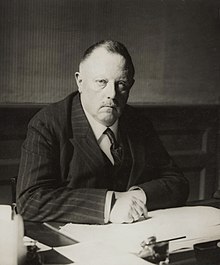Willem Keesom | |
|---|---|
 Willem Keesom in 1926 | |
| Born | 21 June 1876 Texel, Netherlands |
| Died | 3 March 1956 (aged 79) Leiden, Netherlands |
| Known for | helium |
| Scientific career | |
| Fields | physics |
| Doctoral advisor | Johannes Diderik van der Waals |
Willem Hendrik Keesom (/ˈkeɪsoʊm/[1][2]) (21 June 1876, Texel – 3 March 1956, Leiden) was a Dutch physicist who, in 1926, invented a method to freeze liquid helium. He also developed the first mathematical description of dipole–dipole interactions in 1921. Thus, dipole–dipole interactions are also known as Keesom interactions. He was previously a student of Heike Kamerlingh Onnes, who had discovered superconductivity (a feat for which Kamerlingh Onnes received the 1913 Nobel Prize in Physics).
He also discovered the lambda point transition specific-heat maximum between Helium-I and Helium-II in 1930.[3]
In 1924 he became member of the Royal Netherlands Academy of Arts and Sciences.[4] In 1966, the minor planet 9686 Keesom was named after him.
- ^ Willem Hendrik Keesom pronunciation
- ^ Voiceless E
- ^ Guenault, Tony (2003). Basic Superfluids (First ed.). London: Taylor & Francis. p. 25. ISBN 0748408916. Retrieved 2 May 2020.
- ^ "Willem Hendrik Keesom (1876 - 1956)". Royal Netherlands Academy of Arts and Sciences. Retrieved 28 July 2015.